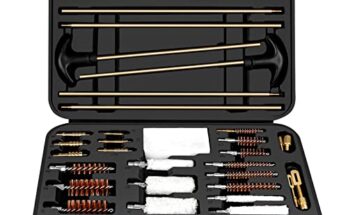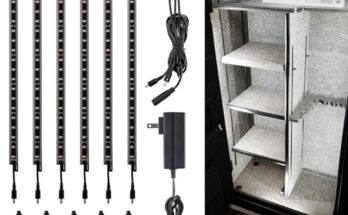Yes, you can shoot coyotes at 100 yards with a powerful air rifle accurately. Hunting coyotes with an air rifle at 100 yards is feasible but requires precision.
Air rifles with high velocity and accuracy, such as PCP or break-barrel models, are recommended for this purpose. Coyotes are agile and alert animals, making shot placement crucial to ensure a humane and successful hunt. It is essential to use appropriate calibers and quality pellets to achieve the required impact and penetration at a longer distance.
Additionally, practicing shooting at various distances and conditions is key to sharpening your skills for a successful coyote hunt with an air rifle.
Understanding Coyotes Behavior
Coyotes are known for their cunning and elusive nature, making them challenging targets for hunters. To effectively hunt coyotes, one must understand their behavior and habits.
Hunting Habits Of Coyotes
Coyotes are primarily nocturnal hunters, relying on their keen sense of smell and hearing. They are opportunistic predators, preying on small mammals, birds, and carrion.
Territorial Behavior
Coyotes are territorial animals, marking their boundaries with urine and howling to deter intruders. Understanding their territorial behavior can help hunters locate and track coyotes effectively.
Choosing The Right Air Rifle
Factors To Consider
When selecting an air rifle for coyote shooting at 100 yards, there are certain factors to keep in mind:
- Power and Velocity
- Accuracy and Precision
- Build Quality
- Operational Noise Level
Best Caliber For Long-distance Shooting
The .22 caliber is considered the most effective for long-distance shooting with air rifles due to its superior accuracy at extended ranges.
Scope Selection And Setup
When it comes to shooting coyotes with an air rifle at 100 yards, the right scope selection and setup are crucial for accuracy and precision. A quality scope and proper zeroing are essential for ensuring your shots are on target and humane. Let’s explore the importance of a quality scope and the process of zeroing the scope for precision hunting.
Importance Of A Quality Scope
A quality scope is the cornerstone of long-range shooting with an air rifle. It allows clear target acquisition and precise aim, enabling you to effectively hit your target at 100 yards. Look for a scope with high magnification and clarity to ensure maximum visibility of your target. An adjustable objective lens can also help in achieving clear focus at longer distances.
Zeroing The Scope For Precision
Zeroing the scope is the process of aligning the point of aim with the point of impact at a specific distance. Start by mounting your scope properly and securing it in place. Then, use a stable shooting platform to ensure consistency in your shooting. Utilize the rifle’s adjustment dials to zero the scope at 100 yards, taking into account factors such as wind and bullet drop.
Mastering Long-distance Shooting Techniques
When it comes to shooting coyotes at 100 yards with an air rifle, mastering long-distance shooting techniques is key. To hit your target with precision and efficiency, it is essential to understand stable shooting positions, windage and elevation adjustments.
Stable Shooting Positions
Stable shooting positions play a crucial role in achieving accuracy when shooting coyotes at long distances. By maintaining a stable shooting position, you minimize unwanted movement and increase your chances of hitting the target. Here are a few stable shooting positions to consider:
- Prone: Lying flat on the ground, with your body parallel to the target, provides excellent stability and reduces body movement.
- Supported Kneeling: Resting your rifle on a stable surface, such as a bipod or shooting sticks, while kneeling can offer improved stability and a better line of sight.
- Sitting: Using a sturdy object, such as a tree stump or shooting rest, to support your rifle while sitting can help minimize body sway and enhance precision.
Windage And Elevation Adjustments
Accounting for windage and elevation is vital for accurately shooting at long distances with an air rifle. Wind and bullet drop can significantly impact your shot placement, but with the right adjustments, you can increase your chances of hitting the target. Here’s what you need to know:
| Adjustment | Description |
|---|---|
| Windage | Windage refers to the horizontal adjustment required to compensate for the effect of wind on the bullet’s path. Wind direction and speed should be considered when making windage adjustments. |
| Elevation | Elevation adjustment accounts for the bullet drop over distance. As the bullet travels farther, it experiences a downward trajectory. By adjusting the elevation, you can compensate for this drop and maintain accuracy. |
By mastering the art of stable shooting positions and understanding windage and elevation adjustments, you can enhance your long-distance shooting skills and increase your success when shooting coyotes with an air rifle.
Understanding Coyote Vocalizations
Discovering the nuances of coyote vocalizations is crucial in determining their behavior and presence. While air rifles are effective for controlling coyote populations, shooting at a distance of 100 yards requires skill and precision. Understanding the capabilities of your air rifle and practicing proper shooting techniques are essential for successful coyote management.
Understanding Coyote Vocalizations Coyotes are known for their vocal nature, and their distinct calls can provide crucial insights into their behavior and intentions. By decoding these vocalizations, hunters can gain a significant advantage in their pursuit. In this section, we will explore the art of interpreting coyote calls and how you can use them to your advantage during your hunting expeditions. Interpreting Coyote Calls Coyote calls can vary in pitch, duration, and intensity, each carrying a different message. Understanding these calls can help you gauge the coyote’s location, level of caution, and even its mood. Here are some common coyote calls and their meanings: 1. Howls – These long, eerie calls are often heard during dusk or dawn and serve multiple purposes for the coyotes. A lone howl can indicate territorial boundaries or a solitary search for a mate. On the other hand, group howls signal social bonding or rally the pack before hunting. 2. Barks – Short and rapid, barks are an aggressive warning sign often used when coyotes feel threatened or are defending their territory against intruders. The intensity of the barking can indicate their level of aggression. Using Calls to Your Advantage Now that you understand the basics of coyote vocalizations, let’s explore how you can use their calls to your advantage during your hunting endeavors. By leveraging their communication, you can attract them towards your location or trick them into exposing themselves. 1. Using Calls for Attraction – By imitating the sounds of distressed prey, such as rabbit distress calls or fawn bleats, you can pique the curiosity of nearby coyotes. This can lead them to move in your direction, providing you with an opportunity to take a well-placed shot. 2. Decoy Calls – Utilizing electronic or manual decoy calls can amplify the effectiveness of your hunting strategy. These decoys emit coyote vocalizations, attracting their attention and diverting it from your actual location. This technique allows you to create a distraction and set up for a better shot. In conclusion, understanding coyote vocalizations is a valuable skill for any coyote hunter. By interpreting their calls and using them to your advantage, you can increase your chances of a successful hunt. Now that you are equipped with this knowledge, go out there and let the coyotes’ own language work in your favor. Remember, patience and practice are key to mastering the art of coyote vocalization interpretation. Good luck hunting!Selecting The Ideal Hunting Location
Factors For Choosing A Spot
When hunting coyotes with an air rifle, selecting the right location is crucial for a successful and ethical hunt. Consider factors such as open fields, wooded areas, or agricultural land where coyotes are likely to be found. Stealth and camouflage are also vital, so opting for spots with natural cover is advisable.
- Open fields
- Wooded areas
- Agricultural land
Ensuring Safety And Legal Compliance
Before heading out, it’s essential to ensure that the chosen hunting location is safe and legally permissible for hunting coyotes. Check the local regulations regarding air rifle usage and hunting permissions. Always prioritize safety by considering factors such as nearby human activity, identifying safe shooting lanes, and having a clear understanding of the surrounding terrain.
Implementing Effective Stealth Tactics
To effectively ambush coyotes with an air rifle, mastering concealment techniques is crucial.
- Choose a strategic position with natural cover like bushes or trees.
- Blend in by wearing camouflaged clothing that matches your surroundings.
- Avoid sudden movements that may alert the coyote to your presence.
Proper scent control is essential for staying undetected by coyotes.
- Eliminate human odors by washing clothes in scent-free detergent.
- Use scent-neutralizing sprays on equipment and gear.
- Position yourself upwind to prevent your scent from reaching the coyote.
Retrieving And Handling The Downed Coyote
Retrieving and handling the downed coyote can be done effectively using an air rifle at a distance of 100 yards. With careful aim and skill, it is possible to shoot coyotes with an air rifle, providing a humane and efficient method of dealing with these animals.
Approaching The Target Safely
When approaching a downed coyote, remain cautious and alert. Keep your firearm pointed in a safe direction at all times. Ensure the coyote is completely immobilized before getting closer. Approach from the side rather than head-on.Ethical And Legal Considerations
Ensure that you have the legal right to shoot coyotes in your area. Understand and adhere to hunting regulations and property laws. Treat the downed coyote with respect and ensure a humane and ethical end to its life. Consider the implications of your actions on the ecosystem.Frequently Asked Questions Of Can You Shoot Coyotes At 100yrds With An Air Rifle
Can You Effectively Shoot Coyotes At 100 Yards With An Air Rifle?
Yes, it is possible to shoot coyotes at a distance of 100 yards with an air rifle. However, it’s crucial to use a powerful air rifle with a high FPS (feet per second) and a heavy pellet for optimal accuracy and stopping power.
Additionally, precise shooting skills and knowledge of coyote behavior are essential for a successful hunt.
Conclusion
In the quest to manage coyote populations, air rifles offer a viable solution. With the right equipment and skills, it’s possible to shoot coyotes at 100 yards. By employing good marksmanship and selecting an appropriate air rifle, hunters can effectively target these elusive predators.
This alternative method can bring success to those seeking to control coyote populations while respecting local hunting regulations.

